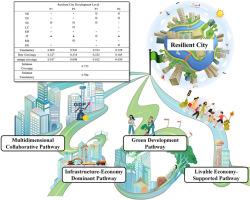Where do resilient cities grow? Exploring the pathways and mechanisms of resilience development
IF 12
1区 工程技术
Q1 CONSTRUCTION & BUILDING TECHNOLOGY
引用次数: 0
Abstract
Why do some cities show greater resilience than others within the same estuarine delta region? While many studies have identified the factors of urban resilience, few have examined how these factors interact to produce resilient outcomes under different local conditions. This study proposes a two-pronged methodology combining “calculation” and “explanation” to explore the mechanisms shaping resilience in estuarine delta cities. Using data from the Yangtze River Delta (YRD), this study integrated fuzzy-set Qualitative Comparative Analysis (fsQCA) and Necessary Condition Analysis (NCA) to identify not only the main drivers but also the specific configurations through which resilience develops. The spatial clustering of urban resilience revealed a geographically concentrated pattern of resilience performance, highlighting significant differences in institutional response and development paths across cities. Additionally, it found that industrial transformation and environmental governance are vital for improving urban resilience. Four distinct yet equally effective development pathways have been identified: Multidimensional Collaborative, Infrastructure–Economy Dominant, Green Development, and Livable Economy–Supported. Each pathway aligns with specific city profiles and capacity conditions. This work offers a practical and adaptable framework for building resilience in delta megaregions, supporting context-sensitive policy design that addresses structural and systemic urban vulnerabilities.

弹性城市在哪里发展?探索弹性发展的途径和机制
为什么同一河口三角洲地区的一些城市比其他城市表现出更强的恢复能力?虽然许多研究已经确定了城市弹性的因素,但很少有人研究这些因素如何在不同的当地条件下相互作用以产生弹性结果。本研究提出了“计算”与“解释”相结合的双管齐下的方法来探讨河口三角洲城市韧性的形成机制。本文利用长江三角洲地区的数据,运用模糊集定性比较分析(fsQCA)和必要条件分析(NCA)相结合的方法,确定了长江三角洲地区弹性发展的主要驱动因素和具体配置。城市弹性的空间聚类揭示了弹性绩效的地理集中格局,突出了城市间制度响应和发展路径的显著差异。此外,研究发现,产业转型和环境治理对提高城市韧性至关重要。已经确定了四种不同但同样有效的发展路径:多维协作、基础设施经济主导、绿色发展和宜居经济支持。每条路径都与特定的城市概况和容量条件相一致。这项工作为三角洲特大地区的韧性建设提供了一个实用且适应性强的框架,支持针对城市结构性和系统性脆弱性的政策设计。
本文章由计算机程序翻译,如有差异,请以英文原文为准。
求助全文
约1分钟内获得全文
求助全文
来源期刊

Sustainable Cities and Society
Social Sciences-Geography, Planning and Development
CiteScore
22.00
自引率
13.70%
发文量
810
审稿时长
27 days
期刊介绍:
Sustainable Cities and Society (SCS) is an international journal that focuses on fundamental and applied research to promote environmentally sustainable and socially resilient cities. The journal welcomes cross-cutting, multi-disciplinary research in various areas, including:
1. Smart cities and resilient environments;
2. Alternative/clean energy sources, energy distribution, distributed energy generation, and energy demand reduction/management;
3. Monitoring and improving air quality in built environment and cities (e.g., healthy built environment and air quality management);
4. Energy efficient, low/zero carbon, and green buildings/communities;
5. Climate change mitigation and adaptation in urban environments;
6. Green infrastructure and BMPs;
7. Environmental Footprint accounting and management;
8. Urban agriculture and forestry;
9. ICT, smart grid and intelligent infrastructure;
10. Urban design/planning, regulations, legislation, certification, economics, and policy;
11. Social aspects, impacts and resiliency of cities;
12. Behavior monitoring, analysis and change within urban communities;
13. Health monitoring and improvement;
14. Nexus issues related to sustainable cities and societies;
15. Smart city governance;
16. Decision Support Systems for trade-off and uncertainty analysis for improved management of cities and society;
17. Big data, machine learning, and artificial intelligence applications and case studies;
18. Critical infrastructure protection, including security, privacy, forensics, and reliability issues of cyber-physical systems.
19. Water footprint reduction and urban water distribution, harvesting, treatment, reuse and management;
20. Waste reduction and recycling;
21. Wastewater collection, treatment and recycling;
22. Smart, clean and healthy transportation systems and infrastructure;
 求助内容:
求助内容: 应助结果提醒方式:
应助结果提醒方式:


